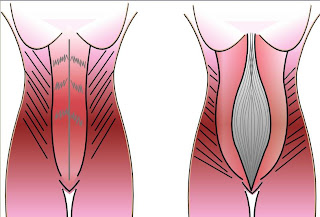Written by Anne Martens, Owner of Bella Bellies; bellabellies.com
Do you find yourself asking the question: " I am no longer pregnant, but why the tummy bulge?". It's embarrassing and we all want full bragging-rights when graduating from elastic, waistband pants.
Do you find yourself asking the question: " I am no longer pregnant, but why the tummy bulge?". It's embarrassing and we all want full bragging-rights when graduating from elastic, waistband pants.
As it turns out, there may be a physiologic basis for this belly "bulge" called diastasis recti. Healing a diastasis recti has nothing to do with crunches. In fact, crunches -or any exercise including forward flexion of the spine while lying down- can make your abdominal muscles MORE saggy.
What is diastasis rectus abdominus?
The rectus abdominus muscle is two "bands" of muscles fibers. Both bands / halves of the rectus abdominus insert into the ribcage and stretch vertically down to the pubic and hip bones. In between these halves is connective tissue, referred to as the linea alba.
 |
| Before a diastasis recti (on the left), after a diastasis recti (on the right) |
During pregnancy the growing uterus and shift in hormones softens and stretches the rectus abdominus. This causes the rectus abdominus to "unzip" or pull apart. This separation allows your growing uterus to move forward. A slight separation of 1-2 centimeters is normal. However a separation greater than 3 centimeters (depending on the individuals frame) may contribute to the postpartum belly bulge. This postpartum bump, is commonly called a diastasis rectus, and it is the protrusion of the internal belly underneath the muscles protruding through.
How does a diastasis recti effect my abdominal strength and tone?
Healing a diastasis rectus abdominus will improve the appearance of your abdominal wall, as well as, improve posture, increase back strength and so much more.
How do I heal a diastasis?
A healthy lifestyle is key. Meaning a balanced diet, cardiovascular activity, resistance training and PROPER core strengthening exercises.
--Eat a healthy, balanced diet, free of unhealthy foods. Excess food is stored all over the body, especially the abdomen region. This excess fat/weight puts forward pressure on your stretched and weakened abdominal muscles, stretching them even further apart.
--Cardiovascular activity
--Resistance training. The stronger your muscles are the more calories you will burn in a given day. Sometimes up to an additional 300 calories a day. Energy required for cardiovascular activity (or any activity) is stored as fats, glycogen and protein. Hence the common statement, "cardiovascular activity burns" . "Burning" fat reduces your overall circumference measurements, including the abdomen region. The burning of excess fat will help reduce pressure against the stretched rectus abdominus.
--Resistance training. The stronger your muscles are the more calories you will burn in a given day. Sometimes up to an additional 300 calories a day. Energy required for cardiovascular activity (or any activity) is stored as fats, glycogen and protein. Hence the common statement, "cardiovascular activity burns" . "Burning" fat reduces your overall circumference measurements, including the abdomen region. The burning of excess fat will help reduce pressure against the stretched rectus abdominus.
--Proper core strengthening exercises. If you have a diastasis recti, the abdominal muscles (particularly the rectus abdominus) must heal. Exercises (such as a crunch) involving forward flexion of the spine in a supine (lying down) position, un-supported plank, un-supported all-fours exercise and jack knifing of the legs will aggravate the weakened abdomen muscular region. It is imperative to avoid these types of exercise until your diastasis recti heals. To heal a diastasis practice isometric abdominal exercises such as plank over an exercise ball, pelvic tilt and bridge from pilates/yoga.
Once you have your health care providers approval to exercise check out this video, highlighting postpartum exercise routines that will strengthen your core. These exercises are safe to practice with or without a diastasis recti. I composed this video at home to highlight some of my favorite Bella Bellies exercises for postpartum http://www.youtube.com/watch?v=KIb7ydkzhpo
Or purchase the Bella Bellies, downloadable Book with a variety of key exercises designed for women at any age or stage of life who have had babies. Email, info@bellabellies.com for more information.
Also, here is a blog I put together on how to check for a diastasis rectus. http://bellabellies.blogspot.com/2013/07/checking-for-diastasis-recti-are-you.html
Once you have your health care providers approval to exercise check out this video, highlighting postpartum exercise routines that will strengthen your core. These exercises are safe to practice with or without a diastasis recti. I composed this video at home to highlight some of my favorite Bella Bellies exercises for postpartum http://www.youtube.com/watch?v=KIb7ydkzhpo
Or purchase the Bella Bellies, downloadable Book with a variety of key exercises designed for women at any age or stage of life who have had babies. Email, info@bellabellies.com for more information.
Also, here is a blog I put together on how to check for a diastasis rectus. http://bellabellies.blogspot.com/2013/07/checking-for-diastasis-recti-are-you.html
No comments:
Post a Comment